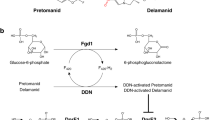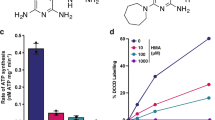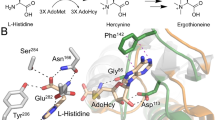Abstract
The side effects associated with tuberculosis therapy bring with them the risk of noncompliance and subsequent drug resistance. Increasing the therapeutic index of antituberculosis drugs should thus improve treatment effectiveness. Several antituberculosis compounds require in situ metabolic activation to become inhibitory. Various thiocarbamide-containing drugs, including ethionamide, are activated by the mycobacterial monooxygenase EthA, the production of which is controlled by the transcriptional repressor EthR. Here we identify drug-like inhibitors of EthR that boost the bioactivation of ethionamide. Compounds designed and screened for their capacity to inhibit EthR-DNA interaction were co-crystallized with EthR. We exploited the three-dimensional structures of the complexes for the synthesis of improved analogs that boosted the ethionamide potency in culture more than tenfold. In Mycobacterium tuberculosis–infected mice, one of these analogs, BDM31343, enabled a substantially reduced dose of ethionamide to lessen the mycobacterial load as efficiently as the conventional higher-dose treatment. This provides proof of concept that inhibiting EthR improves the therapeutic index of thiocarbamide derivatives, which should prompt reconsideration of their use as first-line drugs.
This is a preview of subscription content, access via your institution
Access options
Subscribe to this journal
Receive 12 print issues and online access
$209.00 per year
only $17.42 per issue
Buy this article
- Purchase on Springer Link
- Instant access to full article PDF
Prices may be subject to local taxes which are calculated during checkout






Similar content being viewed by others

References
Corbett, E.L. et al. The growing burden of tuberculosis: global trends and interactions with the HIV epidemic. Arch. Intern. Med. 163, 1009–1021 (2003).
Wells, C.D. et al. HIV infection and multidrug-resistant tuberculosis: the perfect storm. J. Infect. Dis. 196 Suppl 1, S86–S107 (2007).
Cox, H. et al. tuberculosis recurrence and mortality after successful treatment: impact of drug resistance. PLoS Med. 3, e384 (2006).
Tomioka, H. Current status of some antituberculosis drugs and the development of new antituberculous agents with special reference to their in vitro and in vivo antimicrobial activities. Curr. Pharm. Des. 12, 4047–4070 (2006).
Scorpio, A. & Zhang, Y. Mutations in pncA, a gene encoding pyrazinamidase/nicotinamidase, cause resistance to the antituberculous drug pyrazinamide in tubercle bacillus. Nat. Med. 2, 662–667 (1996).
Zhang, Y., Heym, B., Allen, B., Young, D. & Cole, S. The catalase peroxidase gene and isoniazid resistance of Mycobacterium tuberculosis. Nature 358, 591–593 (1992).
Manjunatha, U.H. et al. Identification of a nitroimidazo-oxazine–specific protein involved in PA-824 resistance in Mycobacterium tuberculosis. Proc. Natl. Acad. Sci. USA 103, 431–436 (2006).
DeBarber, A.E., Mdluli, K., Bosman, M., Bekker, L.G. & Barry, C.E., III. Ethionamide activation and sensitivity in multidrug-resistant Mycobacterium tuberculosis. Proc. Natl. Acad. Sci. USA 97, 9677–9682 (2000).
Baulard, A.R. et al. Activation of the pro-drug ethionamide is regulated in mycobacteria. J. Biol. Chem. 275, 28326–28331 (2000).
Qian, L. & Ortiz de Montellano, P.R. Oxidative activation of thiacetazone by the Mycobacterium tuberculosis flavin monooxygenase EtaA and human FMO1 and FMO3. Chem. Res. Toxicol. 19, 443–449 (2006).
Dover, L.G. et al. EthA, a common activator of thiocarbamide-containing drugs acting on different mycobacterial targets. Antimicrob. Agents Chemother. 51, 1055–1063 (2007).
Wilson, T.M., Delisle, G.W. & Collins, D.M. Effect of inhA and katG on isoniazid resistance and virulence of Mycobacterium bovis. Mol. Microbiol. 15, 1009–1015 (1995).
Boshoff, H.I. & Mizrahi, V. Expression of Mycobacterium smegmatis pyrazinamidase in Mycobacterium tuberculosis confers hypersensitivity to pyrazinamide and related amides. J. Bacteriol. 182, 5479–5485 (2000).
Engohang-Ndong, J. et al. EthR, a repressor of the TetR/CamR family implicated in ethionamide resistance in mycobacteria, octamerizes cooperatively on its operator. Mol. Microbiol. 51, 175–188 (2004).
Weinstein, H.J., Hallett, W.Y. & Sarauw, A.S. The absorption and toxicity of ethionamide. Am. Rev. Respir. Dis. 86, 576–578 (1962).
Lees, A.W. Ethionamide and isoniazid in previously untreated cases of pulmonary tuberculosis. Dis. Chest 45, 247–250 (1964).
Holdiness, M.R. Neurological manifestations and toxicities of the antituberculosis drugs. A review. Med. Toxicol. 2, 33–51 (1987).
Frénois, F., Engohang-Ndong, J., Locht, C., Baulard, A.R. & Villeret, V. Structure of EthR in a ligand bound conformation reveals therapeutic perspectives against tuberculosis. Mol. Cell 16, 301–307 (2004).
Dover, L.G. et al. Crystal structure of the TetR/CamR family repressor Mycobacterium tuberculosis EthR implicated in ethionamide resistance. J. Mol. Biol. 340, 1095–1105 (2004).
Frénois, F., Baulard, A.R. & Villeret, V. Insights into mechanisms of induction and ligands recognition in the transcriptional repressor EthR from Mycobacterium tuberculosis. Tuberculosis (Edinb.) 86, 110–114 (2006).
Lipinski, C.A., Lombardo, F., Dominy, B.W. & Feeney, P.J. Experimental and computational approaches to estimate solubility and permeability in drug discovery and development settings. Adv. Drug Deliv. Rev. 46, 3–26 (2001).
Lipinski, C.A. Lead- and drug-like compounds: the rule-of-five revolution. Drug Discov. Today Technol. 1, 337–341 (2004).
Veber, D.F. et al. Molecular properties that influence the oral bioavailability of drug candidates. J. Med. Chem. 45, 2615–2623 (2002).
Korduláková, J. et al. Isoxyl activation is required for bacteriostatic activity against Mycobacterium tuberculosis. Antimicrob. Agents Chemother. 51, 3824–3829 (2007).
Vieth, M. et al. Characteristic physical properties and structural fragments of marketed oral drugs. J. Med. Chem. 47, 224–232 (2004).
Kasim, N.A. et al. Molecular properties of WHO essential drugs and provisional biopharmaceutical classification. Mol. Pharm. 1, 85–96 (2004).
Holdiness, M.R. Clinical pharmacokinetics of the antituberculosis drugs. Clin. Pharmacokinet. 9, 511–544 (1984).
Zhu, M. et al. Population pharmacokinetics of ethionamide in patients with tuberculosis. Tuberculosis (Edinb.) 82, 91–96 (2002).
Guo, H., Seet, Q., Denkin, S., Parsons, L. & Zhang, Y. Molecular characterization of isoniazid-resistant clinical isolates of Mycobacterium tuberculosis from the USA. J. Med. Microbiol. 55, 1527–1531 (2006).
Zhang, Y., Vilchèze, C. & Jacobs, W.R. Mechanisms of drug resistance in Mycobacterium tuberculosis. in Tuberculosis and the Tubercle Bacillus (eds. Cole, S.T. et al.) 115–140 (American Society for Microbiology, Washington, DC, 2005).
Morlock, G.P., Metchock, B., Sikes, D., Crawford, J.T. & Cooksey, R.C. ethA, inhA, and katG loci of ethionamide-resistant clinical Mycobacterium tuberculosis isolates. Antimicrob. Agents Chemother. 47, 3799–3805 (2003).
Schaaf, H.S. et al. Minimal inhibitory concentration of isoniazid in isoniazid-resistant Mycobacterium tuberculosis isolates from children. Eur. J. Clin. Microbiol. Infect. Dis. 26, 203–205 (2007).
Phetsuksiri, B. et al. Unique mechanism of action of the thiourea drug isoxyl on Mycobacterium tuberculosis. J. Biol. Chem. 278, 53123–53130 (2003).
Alahari, A. et al. thiacetazone, an antitubercular drug that inhibits cyclopropanation of cell wall mycolic acids in mycobacteria. PLoS One 2, e1343 (2007).
Fajardo, T.T. et al. A clinical trial of ethionamide and prothionamide for treatment of lepromatous leprosy. Am. J. Trop. Med. Hyg. 74, 457–461 (2006).
Hastings, R.C., Gillis, T.P., Krahenbuhl, J.L. & Franzblau, S.G. Leprosy. Clin. Microbiol. Rev. 1, 330–348 (1988).
Kabsch, W. Automatic processing of rotation diffraction data from crystals of initially unknown symmetry and cell constants. J. Appl. Cryst. 26, 795–800 (1993).
Winn, M.D., Isupov, M.N. & Murshudov, G.N. Use of TLS parameters to model anisotropic displacements in macromolecular refinement. Acta Crystallogr. D Biol. Crystallogr. 57, 122–133 (2001).
Collaborative-Computational-Project-Number-4. The CCP4 suite: programs for protein crystallography. Acta Crystallogr. D Biol. Crystallogr. 50, 760–763 (1994).
Emsley, P. & Cowtan, K. Coot: model-building tools for molecular graphics. Acta Crystallogr. D Biol. Crystallogr. 60, 2126–2132 (2004).
Snewin, V.A. et al. Assessment of immunity to mycobacterial infection with luciferase reporter constructs. Infect. Immun. 67, 4586–4593 (1999).
Acknowledgements
We are indebted to G. Mahieu for his invaluable help with the synergistic experiments on M. tuberculosis, P. Rucktooa for crystal structure acquisitions and manipulations, F. Demirkaya for technical support, M. Flipo for support in chemical synthesis, M. Cynamon for sharing experimental data about ethionamide sensitivity in mice and S. Delaroche for data formatting. We thank H. Gras for critical reading of the manuscript and F. Jean, C. Desruelle and V. Dewailly for grants management. Nuclear magnetic resonance spectra acquisitions were done at the Laboratoire d'Application de Résonance Magnétique Nucléaire, Lille. This work was supported by INSERM, Université de Lille 2 Droit et Santé, Institut Pasteur de Lille, CNRS, the Région Nord-Pas de Calais, Ministère délégué à la Recherche et aux Nouvelles Technologies and the European Union (FEDER OBJ2-4.1-2006/3-n°297/9360), l'Agence Nationale de la Recherche, France (ANR-06-EMPB-033). We are indebted to the European Synchrotron Radiation Facility for beam-time allocation (through the Block Allocation Group BAG MX-485) for this project. X.C. is a recipient of a doctoral fellowship from Institut Pasteur de Lille and the Région Nord-Pas de Calais. B.D. is a recipient of a doctoral fellowship of the Ministère de la Recherche. M.A. and V.V. are researchers from the CNRS.
Author information
Authors and Affiliations
Corresponding author
Supplementary information
Supplementary Text and Figures
Supplementary Figs. 1–5 and Supplementary Tables 1–9 (PDF 3188 kb)
Rights and permissions
About this article
Cite this article
Willand, N., Dirié, B., Carette, X. et al. Synthetic EthR inhibitors boost antituberculous activity of ethionamide. Nat Med 15, 537–544 (2009). https://doi.org/10.1038/nm.1950
Received:
Accepted:
Published:
Issue Date:
DOI: https://doi.org/10.1038/nm.1950
This article is cited by
-
The implication of Mycobacterium tuberculosis-mediated metabolism of targeted xenobiotics
Nature Reviews Chemistry (2023)
-
Rubrolone production by Dactylosporangium vinaceum: biosynthesis, modulation and possible biological function
Applied Microbiology and Biotechnology (2021)
-
Mycobacterium tuberculosis FasR senses long fatty acyl-CoA through a tunnel and a hydrophobic transmission spine
Nature Communications (2020)
-
Combined chemical genetics and data-driven bioinformatics approach identifies receptor tyrosine kinase inhibitors as host-directed antimicrobials
Nature Communications (2018)
-
CD82 hypomethylation is essential for tuberculosis pathogenesis via regulation of RUNX1-Rab5/22
Experimental & Molecular Medicine (2018)


